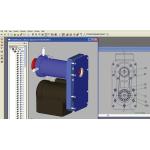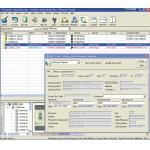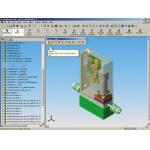Latest News
March 1, 2006
By Jerry Waxler
Proper implementation of the right EDM system can reap benefits for your company’s processes and bottom line.
Most companies will implement only one new document management solution over the course of a decade, and most staff members probably won’t be involved in implementing more than three systems in a lifetime. And yet research shows that implementing such systems is one of the most cost-effective changes a company can make. These systems have proven to benefit company processes and even greater benefits for a company’s bottom line. The trick is deciding what system to use and how to implement it.
Fortunately, many companies that have already planned and implemented engineering data management (EDM) systems successfully are willing to share helpful guidelines and lessons learned. What did they do to make their implementation work? Who did they involve in the process? What was their strategy? What would they do differently? These questions are answered here by people who took the plunge. Each has found fast return on investment (ROI) in increased efficiency and significant productivity gains from their EDM systems.
Getting the Big Picture Is Critical
In many manufacturing companies, engineers are so busy simply trying to get their immediate jobs completed that they seldom have time to step back and analyze the big picture, let alone put important management systems in place. When they don’t effectively manage their data, they certainly feel the pain. However, they may not recognize how much time and money is lost as a result of such inefficiency. Major productivity increases come into focus when someone on the team steps forward to evaluate and recommend process changes.
º º EDM systems such as Synergis Adept, here working within SolidWorks, provide data management functions such as sign in and sign out inside the CAD application to ensure controlled access.
Thorough evaluation and planning are crucial for a smooth implementation. One of the most powerful methods is to assemble an EDM evaluation team made up of representatives of all departments that will be impacted by the implementation of a document management system.
Innovative Steam Technologies (IST) in Cambridge, Ontario, selected a group of individuals to be responsible for the whole process from software evaluations to implementation. They were drawn from key areas of the company, with a wide variety of skill sets, and were dedicated to the planning, designing, migrating, and training for their EDM system. They also had the important task of testing the EDM solution’s capabilities to make sure the software did what the company wanted it to do.
Another company that understood the importance of evaluation and planning was Ferrotec USA of Nashua, NH. According to Dave Anderson, CAD supervisor at Ferrotec, “We knew it was time to implement a document management system. We first formed an EDM committee, with managers from CAD, IT/IS, manufacturing, engineering, R&D, and documentation, to discuss all our options to ensure the needs of different people from different skill sets and responsibilities were going to be met. During our two-month evaluation process, we looked at everything from doing it ourselves with an access database… to something out of the box.”
Define Requirements and Prepare For Loading data-Ahead of Time
A constant theme of every successful EDM implementation is setting standard procedures. IST’s Glenda Martin-Barnes, coordinator and EDM administrator, reflected that before starting the EDM implementation, the team spent considerable time defining existing and new procedures; defining requirements for transition to the new EDM system; developing a written document that defined what was required to transition from manual to electronic; and testing the plan, procedures, and system.
Another critical consideration for companies that are in the preparation phase is how to load legacy data into the EDM system. Legacy data can come in many forms. Some companies use spreadsheets as a rudimentary document tracking system. They typically include drawing file names and related information such as project number, customer name, and file location. This metadata (data about the files) can be used as a guide to migrate and populate the EDM system database.
¹ ¹ With an EDM system, Inventor 3D models and associated 2D drawings can be managed and tracked effectively to maintain the relationships between parts and assemblies.
At IST, the biggest challenge was migrating and linking Windows and Unix-based legacy data and documents to its EDM system. With the help of the vendor’s data migration team, IST was able to capture and record data from its Unix database; import it into the EDM database; link the legacy documents and records; and merge with the current record and drawing file. Also, IST scanned hard-copy drawings and linked the images to their respective database records.
To make the transition as seamless as possible, the IST team agreed on two stages of migration. First, it migrated and synchronized the current active project documents. Second, it migrated and synchronized all the historic records, data, and files. All the planning paid off. The transition to EDM was smooth and IST’s existing document process was transitioned with all the data intact. Once the system was live, it was being used fully with less than one week of training.
Prepare for the Roll Out with a Pilot and Training
Before the actual EDM roll out, many companies test the system in a pilot or sample setting. In other words, they load up some sample data, have people experiment with it, and offer some basic training and orientation. Because it’s not a live work environment, people can try out features and sample scenarios without the pressure of impacting production. This pre-implementation time can also be used to train the designated system administrator as well as several “power” users to help others down the road.
According to Bryan Balzer, CAD manager at Syndicate Systems, a division of Leggett & Platt located in Middlebury, IN, administration training was a tremendous value. “It kept us from making mistakes up front and got us to where we wanted to go quicker.”
º º Metadata, or the data about the document, is stored in an EDM system and enables users to search for and find drawings quickly and easily.

To make certain everyone got up to speed with the new system at AWB Engineers, an AEC firm in Salisbury, MD, Greg Barfield, IT and CAD manager, ran training sessions for the staff. “The learning curve has been fairly quick,” he said. “Most AWB users caught on very well and were up and running soon after the company’s final day of implementation and training.”
Another way to support the rollout is to schedule formalized training, which is followed up by a post-rollout Q&A session. These post-training sessions can be informal and help address common user questions efficiently at one time.
Phasing in an EDM System
There are commonsense guidelines for scheduling the system rollout. For example, plan to implement an EDM system after a big project, when there’s some slack time, versus when the biggest project of the year is nearing deadline. It’s also a good idea to make absolutely sure that everyone-from managers to users-know your plan. The more communication the better.
For some companies, it makes sense to phase in the implementation to minimize impact on production. At Ferrotec USA, they rolled out Synergis Adept in four phases over six to nine months. Phase 1 was designed to give comprehensive training in Adept to the engineers who create most of the documents. Additional document creators were trained during phase 2. Phase 3 was for people who just wanted to view or access files without editing permissions. The fourth and final phase was to give access to all other global locations.
Similarly, AWB Engineers wanted to proceed slowly and cautiously so there were no abrupt changes to production that could disrupt productivity. “We started our implementation in January and first focused on several projects that could test the system, prior to placing the entire design team into the mix. Because of this, we did not start our normal project flow in EDM for several months,” said Barfield. “In addition, we decided to use the EDM system only on 2005 ]and later] projects. We are keeping our old file management system in place while we complete any projects that were received prior to 2005.”
Surprisingly Fast ROI Mean the Sooner You Do It, The More You’ll Save
Companies are often surprised to learn how little time it takes to get up and running with EDM. According to Mark Luna, senior engineer for the concrete pole products division of Ameron International, in Filmore, CA, implementation time was short. “We were able to install, bring in all of our old drawing files, set up our library cards, and implement the solution in two days,” said Luna. “And, most of that time was spent deciding upon our internal data fields and the manner of our library usage. Installation and importing our old files took no more than a few hours. From there, it was just acclimating to the continuous usage/creation of our library cards for the various files. Additionally, we were able to set up customizable searches rather easily, which has proved to be very helpful.”
“My belief is that, in engineering time alone, we broke even within a few months and continue to achieve returns by way of efficiency and increased productivity,” adds Luna. “Clearly the biggest business benefit of our EDM system for our organization is the increase in engineering productivity. We are able to do so much more now with the same number of people. My impression is that we are at least 50 percent more productive in design and engineering as a result of our utilization of EDM.”
Successful Implementation Translates Into Higher Returns
When there’s a smooth implementation, costs stay down, there are fewer mistakes, and the right data sets get loaded so people can find what they want with less searching. And that smoother implementation translates into a higher ROI. When costs are lower, payback is also faster. And with a smooth transition, worker acceptance is faster. With a well-planned EDM implementation, everyone from managers to users have a satisfying experience.
Jerry Waxler is director of technical communications, Synergis Software, which develops Synergis Adept EDM. To comment on this article, send an e-mail by clicking here. Please reference “EDM, April 2006” in your message.
Synergis Adept
Synergis Software
Quakertown, PA
Also Mentioned
Inventor
Autodesk
San Rafael, CA
SolidWorks
SolidWorks Corp.
Concord, MA
Subscribe to our FREE magazine, FREE email newsletters or both!
Latest News
About the Author
DE’s editors contribute news and new product announcements to Digital Engineering.
Press releases may be sent to them via [email protected].







